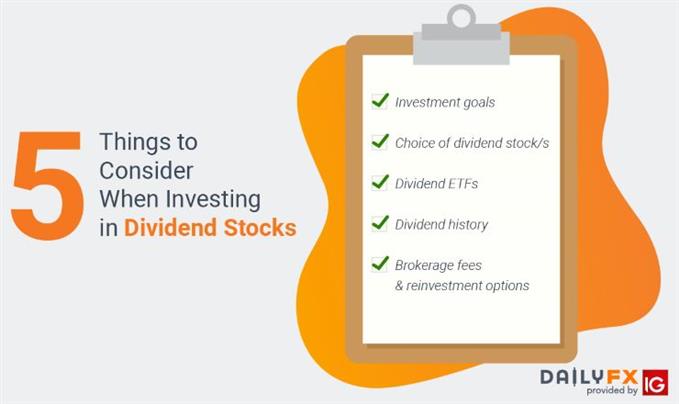Dividend investing may carry the connotation of safety and reliability given that income investors will often investigate these types of stocks; but that may not always be the case. This article explores in-depth how dividend stocks can be analyzed and how to get started.
What is dividend investing?
Dividend investing is the practise of investing in dividend-paying stocks. A stock dividend is a portion of a company’s earnings that is then paid out to shareholders. By owning a share of that company, investors will get paid for owning the stock.
Dividend investing entails thorough stock research for optimal investment decisions.These dividend stocks usually offer regular dividend payments - which do vary in frequency depending on the company, giving investors the potential for a perpetual income stream.
Learn more about dividend stocks
Why invest in dividend stocks?
Investing in dividend stocks can be an attractive way for an investors to attempt to grow wealth long-term through the following avenues:
- Additional and regular revenue stream.
- The dividends issued often allow for investors to employ a dividend reinvestment (DRIP) which means that investors can use these dividends to add to their investment in the same stock rather than taking the cash distribution. Many brokers offer this service. Reinvesting at these regular intervals allow investors to buy stock at varying price points based on the share prices at the time.
- In times of market downturns/recessions, dividends stocks may provide some element of a buffer to the decline in stock prices as dividend-paying stocks may still pay dividends during these periods of market decay. It is, however, important to note that dividends are not guaranteed to continue – and companies do not have to continue paying them in the future, particularly if they see a rough patch ahead and would instead prefer to retain cash on hand to navigate a more turbulent backdrop.
Top 5 Things to Consider before Investing in Dividend Stocks

1. Investment goals
Every investor should have specific financial goals in mind. This involves risk appetite, financial resources and investment time horizon. Understanding investment goals is essential for investors to appropriately select investment options – in this case dividend stocks.
2. Choice ofdividend stock/s
Selecting dividend stocks can be tricky as investors may not know where to begin. Market value ratios can provide investors with important insights to stock market valuations. This can assist the investor in identifying value and growth stocks as well as allowing for comparisons between stocks and across stock sectors or market capitalizations.
3. Dividend ETFs
Investing in dividend stocks does not solely refer to buying individual stocks. Gaining access to dividend stocks can also come through dividend ETFs which provide exposure to a broad selection of dividend-paying stocks. It is important to view the components of the ETF to check if the ETF meets the dividend stock requirements as some ETFs may contain additional/differing constituents such as bonds, commodities etc.
Supplement your knowledge on the differences between ETFs and stocks
4. Dividend history
Selecting a stock solely on the highest proportionate dividend may seem like the obvious theoretical choice however, overall company strength and outlook is important. A company may distribute a large dividend but may be fundamentally unstable with a bleak future. That could cause the company to cut or perhaps even forego dividend payments in the future. This illustrates the importance proper research and analysis rather than just looking for the largest dividend yields.
Compiling a list of high yielding dividend stocks can be a good starting point, after which a deep dive into each company will allow investors to vet those stocks that may be suitable for purchase and those which are not.
5. Brokerage fees and reinvestment options
Choosing the most suitable broker is often overlooked but this can affect an investors ease of trade, cost and suitability. A platform that is easy to use is important as to not confuse investors – novice investors in particular.
Costs play a big part as commission charges can eat into potential returns so ensure to research possible brokers before committing. Investors need to understand how stock investing works in terms of order types, stock market liquidity, trading times and volumes. These simple concepts will help investors with sound investment decisions.
Dividend reinvestment (DRIP) can play a major role for the dividend investing strategy as mentioned previously. Many brokers do not offer this service so be sure to enquire with your broker or prospective brokers about this ability.
How to Invest in Dividend Stocks
Understanding what goes into dividend investing is important but actually implementing that knowledge into an investment decision may be more complex. The hypothetical example below is a simplified version of dividend stock analysis:
Two stocks in the financial sector:
| Stock | Share price | % change YTD | Dividend | Dividend yield | P/E ratio | Payout ratio | Dividend growth (3-year average) |
|---|---|---|---|---|---|---|---|
| Company A | $26.84 | (3.03%) | $2.04 | 7.60% | 9.48 | 46.58% | 9.83% |
| Company B | $10.98 | (4.27%) | $0.71 | 6.47% | 8.62 | 51.08% | 1.08% |
The above data is easily accessible on various financial market data sites. Assume both stocks included operate within the same sector (financial) on the same stock exchange.
Dividend yield
In the above example, the share price of Company A is roughly 2.4x that of Company B. This translates to a similar proportion for the dividend of 2.8x. Thus, Company A has displayed a higher dividend yield based on percentage terms with recent dividend distributions.
Higher dividend yields do not always translate to an attractive investment options, however, as these higher dividend yield figures may be inflated by falling stock prices. This does not seem to apply in this case as it is clear from the percentage change YTD that both Company A and Company B share prices have fallen with Company A less than Company B.
From there – the big question is future expectations and which of the two companies that an investor feels has greater growth potential, producing the possibility of larger dividend payments down-the-road.
P/E ratio
The P/E ratios of both banks are similar with Company A being slightly higher, suggesting that investors are paying more for each dollar of earnings from Company A. This may be due to the larger dividend yield or, perhaps investors are anticipating that Company A has greater growth potential compared with Company B. Remember the P/E ratio is solely a snapshot of a company’s share price divided by its earnings; and thus, only presents a piece of the analytical pie.
Payout ratio
The payout ratios are again similar with Company B marginally edging Company A. These percentages tell investors how much of company’s earnings are going towards dividends. An extremely high payout ratio may be worrying as it can display a lack of confidence from that company to embark on growth initiatives.
Dividend growth YoY
The last criteria in this example looks at dividend growth YoY which shows Company A (9.83%) far exceeded that of Company B (1.08%). This, combined with the higher dividend yield to go along with comparable YTD changes and similar P/E ratios may make Company A seem as a more attractive option with just these few factors of consideration.
It is important, however, to note that there are numerous other considerations to keep into account when selecting an investment, such as company management, growth expectations, market placement, etc.
With any financial decision, investors need to ensure proper risk management and work according to his/her financial status. With this in mind it is also important to look at the overall market positioning and factor in potential global (economic and political) stimuli for sound investment choices.



Investing in Dividend Stocks FAQs
Do all stocks pay dividends?
No, not all stocks pay dividends as this is not an obligatory requirement. Many young growth companies may not pay dividends, instead choosing to reinvest those earnings back into the company for future growth. Stocks that issue dividends are often seen as more mature and may not need to reinvest as much back into the business as younger growth stocks.
To find out what stocks do pay dividends, read our article on Dividend Stocks



